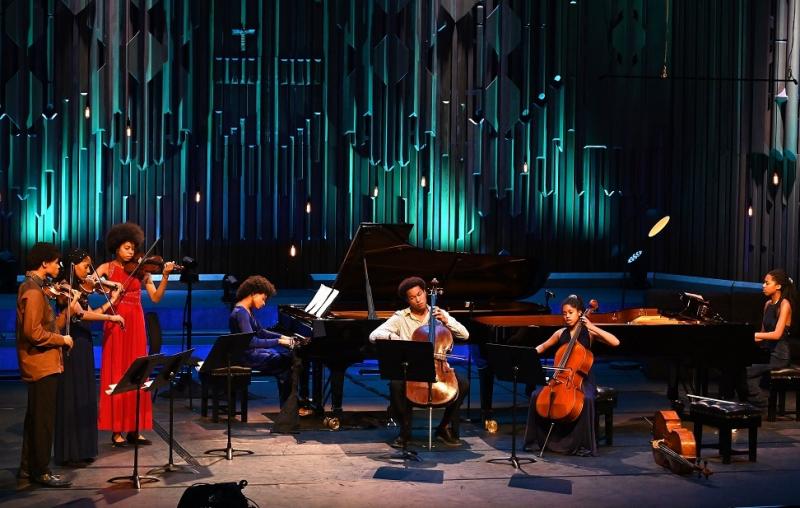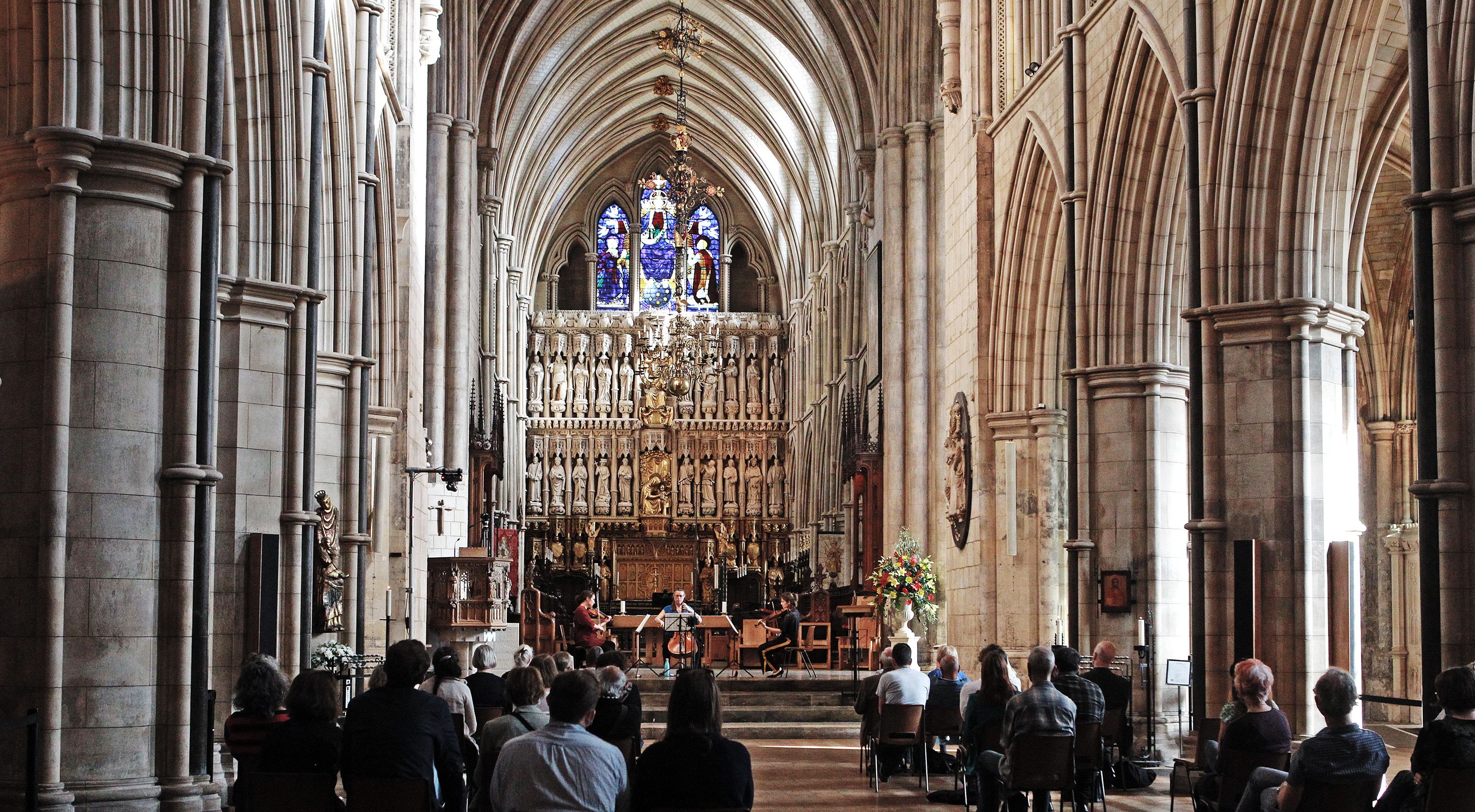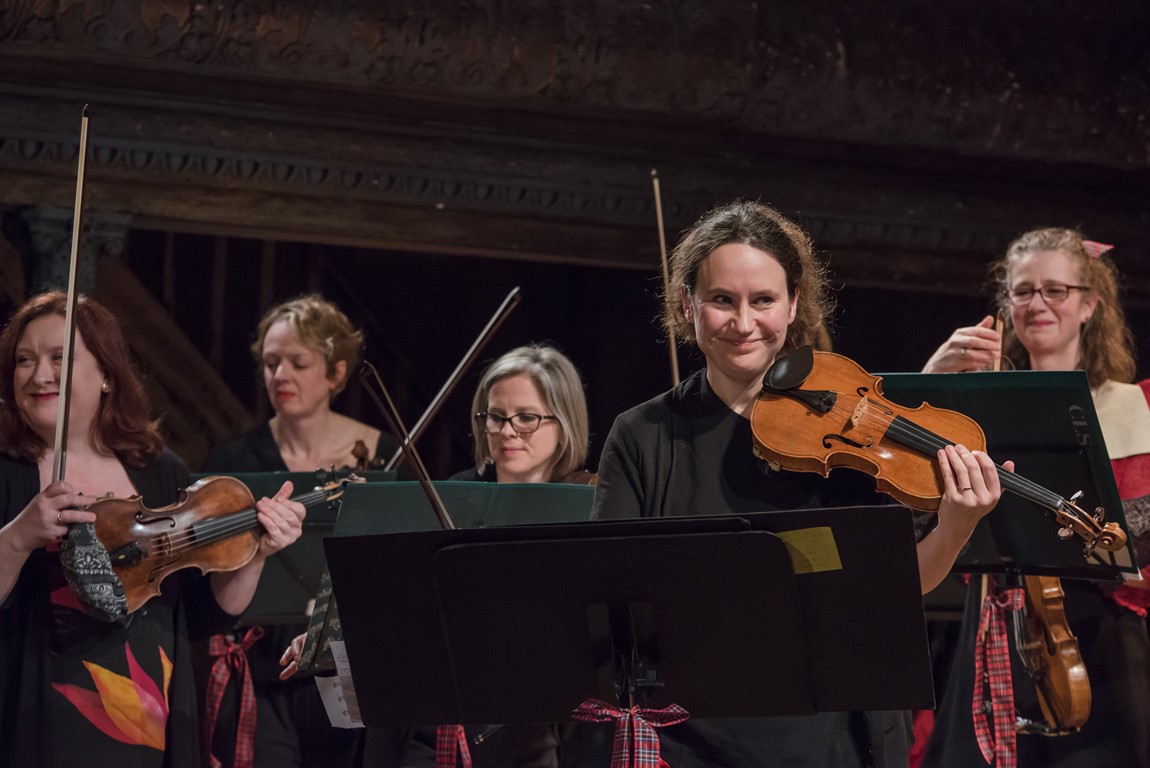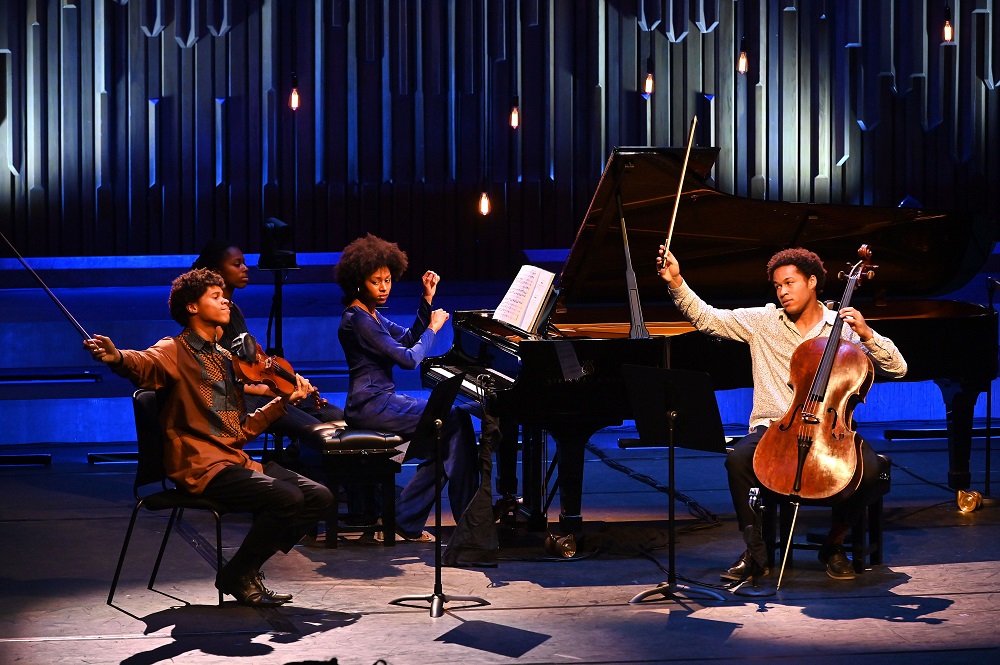City of London Sinfonia, Southwark Cathedral / Kanneh-Masons, Barbican review - soaring teamwork | reviews, news & interviews
City of London Sinfonia, Southwark Cathedral / Kanneh-Masons, Barbican review - soaring teamwork
City of London Sinfonia, Southwark Cathedral / Kanneh-Masons, Barbican review - soaring teamwork
The pure joy of music-making in both events, but with rigour and discipline

“Live music is back,” runs the Barbican's latest slogan, so treasure it and get out there while you can. Thursday evening in London offered an embarrassment of riches.
You could also have taken your pick, if you could get a ticket, between two pianists – Jonathan Plowright at the Wigmore Hall and Charles Owen at the Fidelio Orchestra Café – while the Academy of St Martin in the Fields Chamber Ensemble were playing Mozart and Beethoven at Kings Place’s Hall One and the Minerva Piano Trio had given a lunchtime recital at St John’s Smith Square.
Forgive the list, but it’s good to point out how the programming is almost like old times, albeit without big symphony orchestras and choirs. The gratitude and excitement seem equal on both sides: most soloists and ensembles are still playing in front of an audience for the first time since mid-March. Frissons even in a short mindfulness session from City of London Sinfonia violinist Ann Lovatt before the ensemble’s Serenades for Strings? Absolutely, when the players illustrated the magical intakes of breath which Elgar and Tchaikovsky use to introduce their slow movements. And standing on one leg with mental focus doesn’t seem at all daft when you then feel as listener how the body shifts weight from side to side in the performance, and how wonderful CLS leader and creative programmer Alexandra Wood used the physical freedom common to all the standing players (violins and violas; only the three cellists and the double-bass player sat. Pictured below by Marilyn Kingwill: the previous performance in Southwark Cathedral, a trio arrangement of Bach's Goldberg Variations).  There was the kind of personality in the interpretations you’d expect with a top conductor, and for that, especially in the space given to transitions and climaxes, Wood (pictured below) must take a lot of the credit. When I compared versions of the Tchaikovsky for BBC Radio 3’s Building a Library, there was a marked contrast between chamber orchestras and large symphonic string sections. The best of each proved equally viable, but here we had the virtues combined; Southwark Cathedral acoustics, far from muddying the sound, gave it extra depth and body.
There was the kind of personality in the interpretations you’d expect with a top conductor, and for that, especially in the space given to transitions and climaxes, Wood (pictured below) must take a lot of the credit. When I compared versions of the Tchaikovsky for BBC Radio 3’s Building a Library, there was a marked contrast between chamber orchestras and large symphonic string sections. The best of each proved equally viable, but here we had the virtues combined; Southwark Cathedral acoustics, far from muddying the sound, gave it extra depth and body.
The joy and tenderness of this great masterpiece could have been diffused by the space, but they weren’t, and the freedom to move around, which those who’d bought standing tickets used for a clockwise ambulatory around the fringes, came as an optional extra. The CLS has done a great deal to break down barriers in concert performance, but the essential rigour of live performance still remains.  So it does with the seven Kanneh-Mason siblings, who have too strong a grounding to ever turn into performing seals. Their Barbican programme was beautifully chosen: no single work lasting more than 15 minutes, but within the variety and range of solos and ensembles, plenty of depth as well as sheer chutzpah. It was canny to start with the single-movement C minor Piano Trio of the 16-year-old Shostakovich, the style already the composer we know, love and slightly fear in its nervous tension and chromatic unease; you’ve also got to love the way a sentimental melody finally joins the fray. There’s no doubt that Sheku will always be the top string player, a cellist in a thousand, but Braimah’s more ethereal violin has a poetic personality, too (pictured below, Braimah, left, with Isata and Sheku).
So it does with the seven Kanneh-Mason siblings, who have too strong a grounding to ever turn into performing seals. Their Barbican programme was beautifully chosen: no single work lasting more than 15 minutes, but within the variety and range of solos and ensembles, plenty of depth as well as sheer chutzpah. It was canny to start with the single-movement C minor Piano Trio of the 16-year-old Shostakovich, the style already the composer we know, love and slightly fear in its nervous tension and chromatic unease; you’ve also got to love the way a sentimental melody finally joins the fray. There’s no doubt that Sheku will always be the top string player, a cellist in a thousand, but Braimah’s more ethereal violin has a poetic personality, too (pictured below, Braimah, left, with Isata and Sheku).
That’s true of every real artist here. The three pianists – Isata, Jenaba and Konya – share a crystalline beauty of articulation which was as clear in Konya’s Schubert Impromptu (D899 No. 4 in A flat) as it was in Jeneba‘s (D935 No. 4 in F minor). Most bewitching to watch in action, with upwards glances akin to brother Sheku’s, was Isata in three Gershwin Preludes, cleverly chosen as movements to follow the opening of Barber’s Cello Sonata, with its typically turbulent piano writing; what a marvellously original piece. Of the full-ensemble arrangements, there was special magic in Simon Parkin‘s arrangement of Eric Whitacre's The Seal Lullaby, and the now-familiar family medley from a favourite film, Fiddler on the Roof, has its roots in the school klezmer band participation of four of the family members. The encore, similarly realised for the group by Sheku, Isata and Braimah on Sibelius software with other family members adding their contributions, was a mellow beauty brought to Bob Marley’s Liberation Song.  Full marks to the Barbican on presentation. The light show had been mastered before lockdown; the camera angles are various and impressive. Josie D’Arby’s sweet spirit shines through even if she keeps saying "Shoshtakovich"; I believe in her enthusiasm, which can’t be said for the gushers we’ve been subjected to in some other compering recently. The audience, only dimly visible at the end, were very audible in their support throughout. And I grinned my way through the streamed post-concert addition of questions and answers with the family, lovely parents Kadiatu and Stuart included. To watch, you had to sign up before the concert and then catch it within 48 hours, but I hope the whole thing will be available to all soon. This Von Trapp Family for our time must long remain an inspiration to all.
Full marks to the Barbican on presentation. The light show had been mastered before lockdown; the camera angles are various and impressive. Josie D’Arby’s sweet spirit shines through even if she keeps saying "Shoshtakovich"; I believe in her enthusiasm, which can’t be said for the gushers we’ve been subjected to in some other compering recently. The audience, only dimly visible at the end, were very audible in their support throughout. And I grinned my way through the streamed post-concert addition of questions and answers with the family, lovely parents Kadiatu and Stuart included. To watch, you had to sign up before the concert and then catch it within 48 hours, but I hope the whole thing will be available to all soon. This Von Trapp Family for our time must long remain an inspiration to all.
- CLS Goldberg Variations performance in Southwark Cathedral available to watch on YouTube until 30 October
- Next CLS concerts in Southwark Cathedral on 4 November
- Further events at the Barbican
- More classical music reviews on theartsdesk
rating
Explore topics
Share this article
The future of Arts Journalism
You can stop theartsdesk.com closing!
We urgently need financing to survive. Our fundraising drive has thus far raised £49,000 but we need to reach £100,000 or we will be forced to close. Please contribute here: https://gofund.me/c3f6033d
And if you can forward this information to anyone who might assist, we’d be grateful.

Subscribe to theartsdesk.com
Thank you for continuing to read our work on theartsdesk.com. For unlimited access to every article in its entirety, including our archive of more than 15,000 pieces, we're asking for £5 per month or £40 per year. We feel it's a very good deal, and hope you do too.
To take a subscription now simply click here.
And if you're looking for that extra gift for a friend or family member, why not treat them to a theartsdesk.com gift subscription?
more Classical music
 Bach’s B minor Mass, Irish Baroque Orchestra, Whelan, Christ Church Cathedral, Dublin - everything human and divine
Perfect ensemble runs the gamut of a supreme masterpiece
Bach’s B minor Mass, Irish Baroque Orchestra, Whelan, Christ Church Cathedral, Dublin - everything human and divine
Perfect ensemble runs the gamut of a supreme masterpiece
 Robin Holloway: Music's Odyssey review - lessons in composition
Broad and idiosyncratic survey of classical music is insightful but slightly indigestible
Robin Holloway: Music's Odyssey review - lessons in composition
Broad and idiosyncratic survey of classical music is insightful but slightly indigestible
 Classical CDs: Wolf-pelts, clowns and social realism
British ballet scores, 19th century cello works and contemporary piano etudes
Classical CDs: Wolf-pelts, clowns and social realism
British ballet scores, 19th century cello works and contemporary piano etudes
 Bizet in 150th anniversary year: rich and rare French offerings from Palazzetto Bru Zane
Specialists in French romantic music unveil a treasure trove both live and on disc
Bizet in 150th anniversary year: rich and rare French offerings from Palazzetto Bru Zane
Specialists in French romantic music unveil a treasure trove both live and on disc
 Scottish Chamber Orchestra, Ibragimova, Queen’s Hall, Edinburgh review - rarities, novelties and drumrolls
A pity the SCO didn't pick a better showcase for a shining guest artist
Scottish Chamber Orchestra, Ibragimova, Queen’s Hall, Edinburgh review - rarities, novelties and drumrolls
A pity the SCO didn't pick a better showcase for a shining guest artist
 Kilsby, Parkes, Sinfonia of London, Wilson, Barbican review - string things zing and sing in expert hands
British masterpieces for strings plus other-worldly tenor and horn - and a muscular rarity
Kilsby, Parkes, Sinfonia of London, Wilson, Barbican review - string things zing and sing in expert hands
British masterpieces for strings plus other-worldly tenor and horn - and a muscular rarity
 From Historical to Hip-Hop, Classically Black Music Festival, Kings Place review - a cluster of impressive stars for the future
From quasi-Mozartian elegance to the gritty humour of a kitchen inspection
From Historical to Hip-Hop, Classically Black Music Festival, Kings Place review - a cluster of impressive stars for the future
From quasi-Mozartian elegance to the gritty humour of a kitchen inspection
 Shibe, LSO, Adès, Barbican review - gaudy and glorious new music alongside serene Sibelius
Adès’s passion makes persuasive case for the music he loves, both new and old
Shibe, LSO, Adès, Barbican review - gaudy and glorious new music alongside serene Sibelius
Adès’s passion makes persuasive case for the music he loves, both new and old
 Anja Mittermüller, Richard Fu, Wigmore Hall review - a glorious hall debut
The Austrian mezzo shines - at the age of 22
Anja Mittermüller, Richard Fu, Wigmore Hall review - a glorious hall debut
The Austrian mezzo shines - at the age of 22
 First Person: clarinettist Oliver Pashley on the new horizons of The Hermes Experiment's latest album
Compositions by members of this unusual quartet feature for the first time
First Person: clarinettist Oliver Pashley on the new horizons of The Hermes Experiment's latest album
Compositions by members of this unusual quartet feature for the first time
 Gesualdo Passione, Les Arts Florissants, Amala Dior Company, Barbican review - inspired collaboration excavates the music's humanity
At times it was like watching an anarchic religious procession
Gesualdo Passione, Les Arts Florissants, Amala Dior Company, Barbican review - inspired collaboration excavates the music's humanity
At times it was like watching an anarchic religious procession
 Classical CDs: Camels, concrete and cabaret
An influential American composer's 90th birthday box, plus British piano concertos and a father-and-son duo
Classical CDs: Camels, concrete and cabaret
An influential American composer's 90th birthday box, plus British piano concertos and a father-and-son duo

Add comment